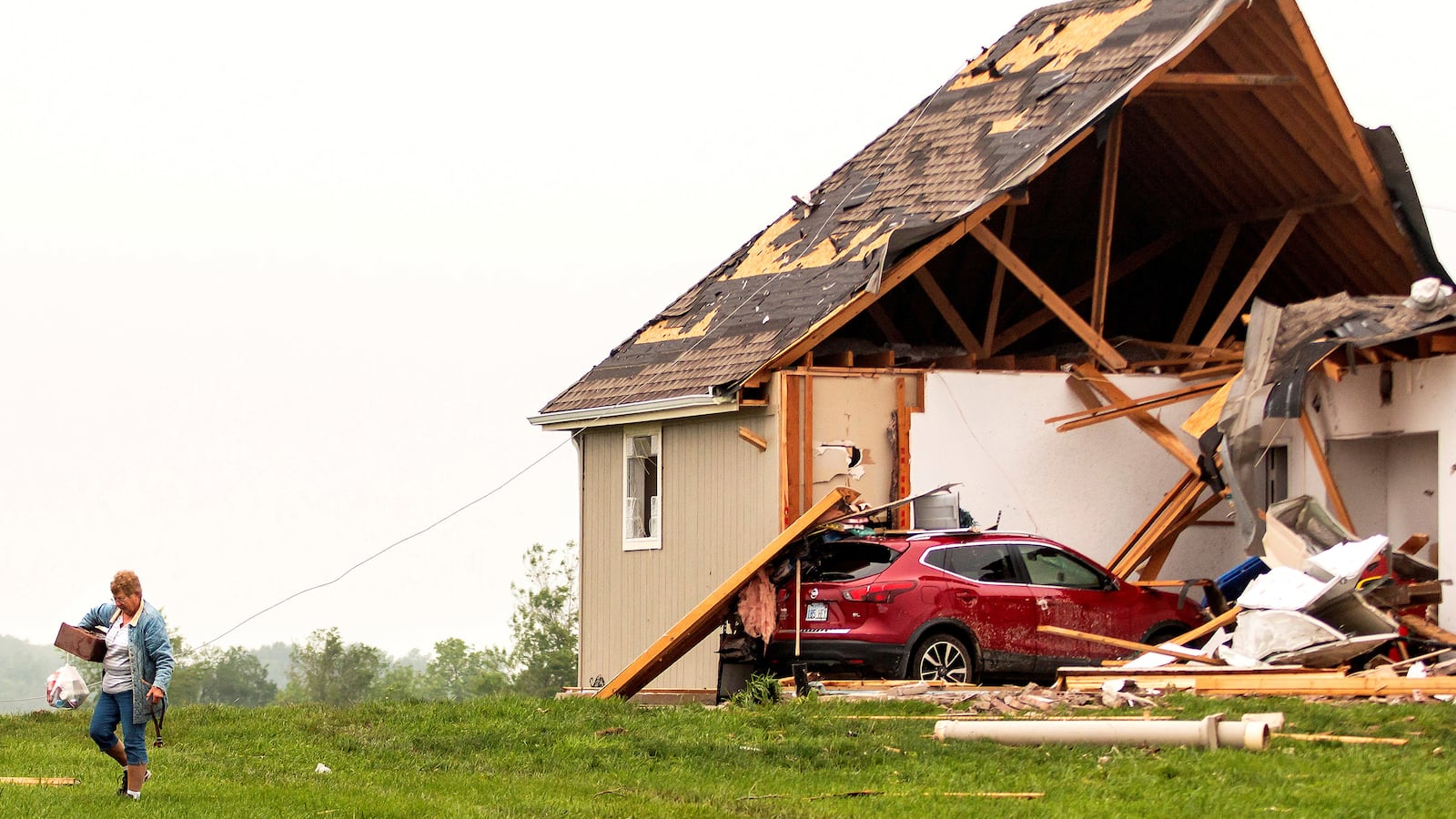This year’s tornado season has been relentless. Millions of Americans across the country saw deadly tornadoes firsthand this week, including a Kentucky man who was killed Wednesday when a roof flew off of a building and struck his vehicle; a Kansas family whose home was literally blown to pieces while they hid underneath a mattress; Ohio residents who are still cleaning up the wreckage after a record-breaking 15 twisters tore through; and an Indiana neighborhood where at least 75 homes were damaged when eight tornadoes touched down Monday.
Within a single month, the National Oceanic and Atmospheric Administration has received over 500 eyewitness reports of tornadoes in just 30 days, according to Bill Bunting, chief of forecast operations at NOAA. And at least one tornado has touched down every single day since May 16.
With tornado warnings issued in Arkansas, Illinois, Iowa, New Jersey, Pennsylvania, Oklahoma, and Texas on Wednesday, many are wondering what’s behind such a terrifying outbreak.
Experts say there aren’t any easy answers. While they can understand the conditions that cause such aggressive storms, they have no way to tell if things will get worse.
SO YOU WANT TO SURVIVE A TORNADO?
The most important strategy for surviving a tornado? The strategy itself.
“What’s key in situations like this… is how important it is to have a plan for severe weather, know where you’ll go in the event of a storm,” Bunting said. “Survivors always say they had a plan… they knew exactly what to do.”
DESIGNATE YOUR SHELTER
Remember: The more walls between you and the tornado, the better.
“If you do not have a designated storm shelter the safest thing to do is to seek shelter in a sturdy building,” Dr. Ernst W. Kiesling, professor emeritus at the National Wind Institute and executive director of the National Storm Shelter Association, told The Daily Beast. “Seek shelter in the central part of the lowest floor in a building.”
How to designate your shelter:
- Everyone in your home should know the location of your shelter.
- Shelters should be centrally located and far away from any windows.
- A shelter can range from a specially built addition, to your bathroom.
- Your shelter should be sturdy. Locate a building, or part of your home, made with reinforced concrete or steel frames.
- Do not stay in a mobile home.
“There are basically two threats: the structural integrity of the building and the other is wind-borne debris, flying debris,” Kiesling said.
MONITOR THE WEATHER
Tornado warnings give you about 10 to 15 minutes to take shelter, according to Bunting. “The key is to identify where the safe areas are… don’t wait until the storm is approaching and the wind is howling,” he said.
The NOAA Storm Prediction Center provides up to date coverage of weather patterns. If there is a dangerous situation, your local weather station will most likely cut into scheduled programming to alert you—whether you like it or not.
According to the Centers for Disease Control and Prevention, signs to look out for in your area are:
- Dark or green-colored sky
- A large, dark, low-lying cloud
- Heavy hail
- A loud roar that sounds like a freight train
KNOW THE LINGO
“Watch” versus “Warning”:
- A tornado watch indicates that “conditions are favorable” for the development of tornadoes in your area, according to The Weather Channel.
- Tornado warnings mean that tornadoes have been sighted in your area, either visually or on radar. “When a tornado warning has been issued, people in the affected area are strongly encouraged to take cover immediately,” according to The Weather Channel.
BATTEN DOWN THE HATCHES
“If you have a tornado warning that means one has been spotted in the area,” Kiesling said. “Get to the safest place you can, a sturdy building, if you’re caught out in the open lie down in a depression.”
- Close all windows. The “exploding house” is a dangerous myth.
- Always wear a helmet. If you have a bicycle helmet, or something similar, wearing it can dramatically improve your chances of survival.
- Stay under a sturdy piece of furniture.
OPEN ROAD
- If possible, leave your vehicle or mobile home and enter a building.
- Do not seek shelter under a highway overpass. An overpass can act like a wind tunnel and actually make people more vulnerable.
- If you do stay in your vehicle, do not try to out-drive a tornado. Drive at a 90-degree angle away from the storm.
CAN WE BLAME CLIMATE CHANGE?
The jury is still out on the role of climate change in the recent surge of tornadoes.
“Projections for climate change in general suggest more days of conditions that can support severe thunderstorms,” Jeff Trapp, department head of atmospheric sciences at the University of Illinois at Urbana-Champaign, told The Daily Beast. “So in that sense these are consistent… it’s a really difficult question to unravel.”
“The other issue is the record is relatively short… and so that also makes it more difficult to extract trends,” Trapp said. “As opposed to temperature… which we have a really long record.”
Tornadoes are recorded primarily to issue tornado warnings from the National Weather Service, not as a research tool, he said.
According to Bunting, there isn’t enough evidence to conclusively link the frequency or intensity of tornadoes to climate change. “What’s really challenging about tornadoes is that the record only goes back to the 1950s, and even then it’s an inconsistent record,” he said.
That may be generous. While a record of tornadoes began during the 1950s, Trapp says the most reliable data actually started being compiled about 40 years later in the 1990s.
“It’s inconclusive whether storms are becoming more intense,” Bunting said. “What we’re seeing is a higher concentration of intense thunderstorms over the past couple of weeks over the same area.”
That “area” stretches from the southwest to the northeast United States.
TORNADO COUNTRY
According to both Bunting and Trapp, the culprit behind the recent spate of tornadoes is, quite simply, the presence of all the ingredients the atmosphere needs to unleash really nasty storms. “The atmosphere is stuck in neutral,” Bunting said. “When it gets stuck in this pattern, the key ingredients are an unstable atmosphere and stronger airflow.”
“That zone of stronger airflow has extended from Texas, up into Iowa, and then eastward to New Jersey,” Bunting said. “As a result we’re seeing round after round of severe storms.”
Trapp describes them as “troughs.” “In the atmosphere we look at waves—the atmosphere is a wavy fluid—there has been a long trough of low pressure over mostly the western half of the U.S.,” he said. “You can think of it as a dip in the jetstream that’s been persistent in that part of the country.”
Why these troughs develop is a question atmospheric scientists are still working to answer. According to Trapp, one explanation is something called “blocking patterns.” These linebackers of the atmosphere occur when pressure systems set up over a region and prevent other weather systems from moving through—forcing other systems to go around it.
“It’s something that we as a community are trying to understand because it affects longer predictions,” Trapp said.
THE FUTURE IS CHAOS
While the National Weather Service is at the forefront of efforts to warn residents of imminent storms, the agency does not offer a long-term outlook for tornadoes.
“This is sort of related to chaos theory. You get beyond a certain time period, and there’s no way to predict with confidence,” Trapp said. “... Members of our community are trying to work on a methodology to create a seasonal outlook on tornadoes.”
In the meantime, the clouds look to be parting on this year’s tornado season.
According to Bunting, NOAA expects a large ridge of high pressure to develop over the central U.S. this weekend. The ridge will diminish the thunderstorm threat, allowing the ground to dry out, and freeing the atmosphere from it’s holding position.
“We actually see an end in sight,” Bunting said.




